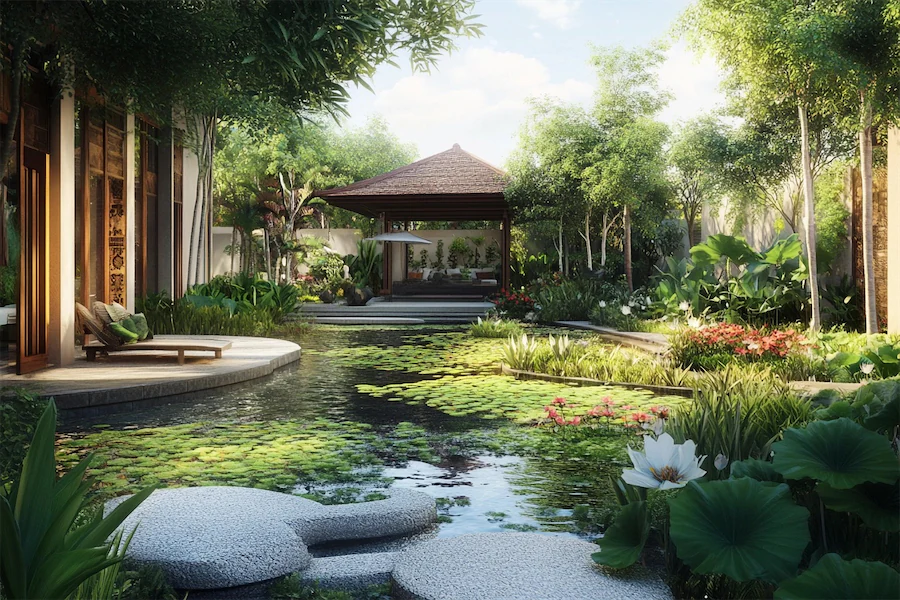A Balinese garden is a tranquil outdoor space that embodies the rich cultural and spiritual heritage of Bali, Indonesia. Characterized by lush tropical vegetation, harmonious water features, and symbolic ornaments, these gardens are designed to evoke a sense of peace and connection with nature.
History and Origins of Balinese Gardens
The design of Balinese gardens is deeply rooted in the island’s Hindu-Buddhist traditions and the philosophy of Tri Hita Karana, which emphasizes harmony between humans, nature, and the divine. Traditional Balinese gardens, known as “pekarangan,” are integral to residential compounds, reflecting a balance between functional and spiritual spaces. These gardens often include areas for religious offerings, family gatherings, and the cultivation of medicinal plants.
Key Features of Balinese Gardens
Balinese gardens incorporate several distinctive elements:
- Lush Tropical Plantings: A variety of plants, including bamboo, banana trees, palms, ferns, and flowering species like frangipani, create a verdant and layered landscape. These plants not only provide shade and beauty but also contribute to the garden’s serene atmosphere.
- Water Features: Ponds, fountains, and water walls introduce the soothing sound of flowing water, symbolizing purification and life. Water elements are often adorned with lotus flowers or koi fish, enhancing the garden’s aesthetic and spiritual appeal.
- Ornamental Structures: Traditional pavilions, known as “bale,” provide spaces for relaxation and contemplation. These open-sided structures are typically crafted from natural materials like wood and thatch, blending seamlessly with the surrounding environment.
- Stone Statues and Carvings: Figures depicting deities, mythological creatures, or animals are strategically placed to serve as focal points and convey cultural narratives. These statues often represent protection, fertility, or prosperity, aligning with Balinese spiritual beliefs.
- Pathways and Flooring: Natural stone or gravel pathways meander through the garden, guiding visitors and creating a sense of journey. The use of organic materials for walkways reinforces the connection to nature and enhances the garden’s rustic charm.
Applications of Balinese Garden Design
Balinese garden principles can be adapted to various settings:
- Residential Gardens: Homeowners can create a personal sanctuary by incorporating Balinese elements, fostering relaxation and a deeper connection to nature. Features like a small pond, a bamboo pavilion, and tropical plantings can transform a backyard into a serene retreat.
- Public Spaces: Parks and community areas can integrate Balinese design to offer visitors a peaceful environment, promoting well-being and cultural appreciation. Incorporating traditional sculptures and water features can enhance the aesthetic appeal and provide educational opportunities about Balinese culture.
- Hospitality Industry: Hotels and resorts often utilize Balinese garden aesthetics to create an exotic and inviting atmosphere, enhancing guest experience. Lush gardens with winding paths, tranquil water features, and traditional architecture contribute to a luxurious and immersive stay.
Considerations When Creating a Balinese Garden
When designing a Balinese-inspired garden, consider the following:
- Climate Compatibility: Select plant species that thrive in your local climate to ensure sustainability and reduce maintenance. While tropical plants are ideal, alternatives that mimic the lushness of Balinese flora can be used in different climates.
- Cultural Sensitivity: Respect the cultural significance of symbols and structures to maintain authenticity and honor Balinese traditions. Understanding the meanings behind certain statues or designs ensures that the garden is both respectful and true to its inspiration.
- Maintenance Requirements: Regular upkeep, including pruning, cleaning water features, and caring for structures, is essential to preserve the garden’s beauty and functionality. Establishing a maintenance routine will help in keeping the garden lush and inviting year-round.
Conclusion
A Balinese garden offers a harmonious blend of nature, art, and spirituality, providing a serene retreat that reflects the island’s rich cultural heritage. By thoughtfully incorporating traditional elements and adapting them to your environment, you can create a tranquil space that fosters relaxation and a deep connection to the natural world.
